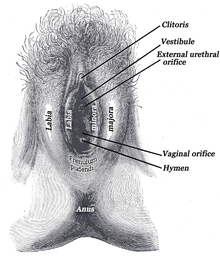Hymen
The hymen (also called maidenhead) is tissue that surrounds or partially covers the external vaginal opening. The hymen has no known use. People used to believe that the hymen always tears after having sexual intercourse for the first time, and that you could tell if a woman was a virgin by looking at her hymen and seeing if it was torn. However, it turns out that it is impossible to tell if someone is a virgin by looking at their hymen.[1] Studies have confirmed that all girls are born with hymens.[2]

Types
changeThere are several different types of hymen. In about 1 in 2,000 females, the hymen does not develop at all.[3] The hymen may also not have a hole in it; this is called an "imperforate hymen". In this case a hole will need to be surgically cut into it to allow menstrual fluid (period blood) out.[4]
Other types are:
- crescent-shaped
- forming a ring around the vagina
- folding in on itself
- has one or more bands going across the opening
- has several holes
What might damage the hymen
changeWhen a girl reaches puberty, the hymen becomes stretchy. The hymen may be damaged by girls fall directly onto sharp objects .[5] Sexual intercourse is another easy way to damage the hymen along with horseback riding and biking. A woman's hymen can also break while playing some sports
This article needs more sources for reliability. |
.
Hymens in other animals
changeThese animals all have a hymen:
There are many more animals which have hymens, but not all are listed here.
The stages of growth
changeWhen a fetus is developing, there is no vaginal opening. The hymen comes from the skin covering the vagina at that time.[6]
In young babies, the hymen is thick and pink. This is because the mother is giving the baby hormones through breast feeding which keeps it thick. In adolescent girls, the hymen becomes thin, smooth and delicate because she has stopped taking in hormones. The hymen becomes very sensitive and can easily cause pain if touched. From puberty, the hymen gets thicker again and becomes pale pink. This is because of the hormone estrogen.
References
change- ↑ Heger, Astrid H.; Emans, S. Jean, eds. (2000). Evaluation of the Sexually Abused Child: A Medical Textbook and Photographic Atlas (PDF) (2nd ed.). New York: Oxford University Press. p. 122. ISBN 9780195074253. Archived from the original (PDF) on 2018-07-08. Retrieved 2018-08-06.
- ↑ Evaluation of the sexually abused child : a medical textbook and photographic atlas. Heger, Astrid., Emans, S. Jean Herriot., Muram, David. (Second ed.). New York: Oxford University Press. 2000. p. 62. ISBN 0-19-513126-6. OCLC 64389654.
An early study by Jenny (1987) confirmed that not all girls are born with hymens.
{{cite book}}: CS1 maint: others (link) - ↑ Kurman, Robert J., ed. (2002). Blaustein's Pathology of the Female Genital Tract (5th ed.). New York: Springer-Verlag. p. 160.
- ↑ Chang, Lisbeth and Muram, David. (2002) "Pediatric & Adolescent Gynecology" in DeCherney, Alan H. and Nathan, Lauren. Current Obstetric & Gynecological Diagnosis & Treatment, 9th edition, McGraw-Hill, 598-602.
- ↑ Emans, S. Jean. "Physical Examination of the Child and Adolescent" (2000) in Evaluation of the Sexually Abused Child: A Medical Textbook and Photographic Atlas, Second edition, Oxford University Press. 64-5
- ↑ 1918 Gray's Anatomy
Other websites
change- The Female Hymen and its Significance[permanent dead link]
- Hymen gallery Archived 2013-01-15 at the Wayback Machine - Pictures of hymens
- The Hymen Revealed Archived 2008-09-13 at the Wayback Machine - by The-Clitoris.com